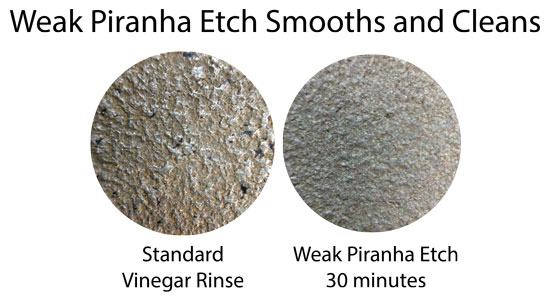Has anybody tried this before?
http://www.genuineideas.com/ArticlesIndex/castironseasoning.html
The article was written by Dr. Greg Blonder, who I've heard of through AmazingRibs.com (an excellent site about BBQ, full of great information much like Doug's work here).
I've never heard of a piranha etch, but the picture of the surface change looks impressive.

According to this document from Carnegie Mellon University, a piranha etch is usually 3:1 sulfuric acid to (H2SO4) to 30% hydrogen peroxide (H2O2).
http://www.cmu.edu/ehs/fact-sheets/piranha-solution-handling.pdf
Dr. Blonder reduces the sulfuric acid to 1/100 and the hydrogen peroxide to 1/10 for his "Weak Piranha Etch" - so it's not as crazy as it sounds in the PDF.
Anyway, I'd be interested in giving this a try if it's really worth it, but I don't know if I would try it on a machined pan.
http://www.genuineideas.com/ArticlesIndex/castironseasoning.html
The article was written by Dr. Greg Blonder, who I've heard of through AmazingRibs.com (an excellent site about BBQ, full of great information much like Doug's work here).
I've never heard of a piranha etch, but the picture of the surface change looks impressive.

According to this document from Carnegie Mellon University, a piranha etch is usually 3:1 sulfuric acid to (H2SO4) to 30% hydrogen peroxide (H2O2).
http://www.cmu.edu/ehs/fact-sheets/piranha-solution-handling.pdf
Dr. Blonder reduces the sulfuric acid to 1/100 and the hydrogen peroxide to 1/10 for his "Weak Piranha Etch" - so it's not as crazy as it sounds in the PDF.
Anyway, I'd be interested in giving this a try if it's really worth it, but I don't know if I would try it on a machined pan.
